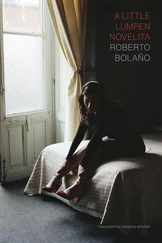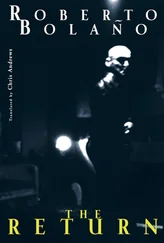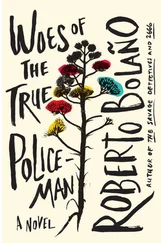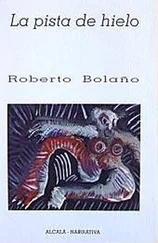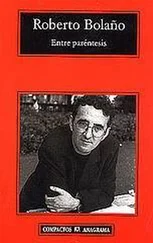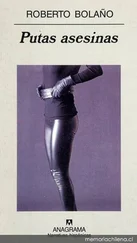Later, a little before dusk, the old woman came with us to El Cubo to show us the house where Cesárea Tinajero had lived. It was near some corrals that were so old they were falling apart, the wood of the cross-pieces rotten, next to what must have been a toolshed, although it was empty now. The house was small, with a dried-up yard to one side, and when we got there we could see light through its only front window. Should we knock? said Belano. There's no point, said Lima. So we went walking back again, through the hills, to the old Pápago woman's house, and thanked her for everything, and then we said good night and headed back alone to El Cubo, although really she was the one who was left alone.
That night we slept at the teacher's house. After we ate, Lima settled down to read William Blake, Belano and the teacher took a walk in the desert and went into her room when they got back, and after Lupe and I washed the dishes, we went out to smoke a cigarette while we watched the stars, and made love in the Impala. When we came back into the house we found Lima asleep on the floor with the book in his hands and a familiar murmur coming from the teacher's room, indicating that neither she nor Belano would appear again for the rest of the night. So we covered Lima with a blanket, made a bed for ourselves on the floor, and turned out the light. At eight in the morning the teacher went into her room and woke up Belano. The bathroom was an outhouse in the backyard. When I returned, the windows were open and there was café de olla on the table.
We said goodbye outside. The teacher didn't want us to give her a ride to the school. When we got back to Hermosillo, I had the feeling that not only had I already been over every inch of this fucking land, but that I'd been born here.
JANUARY 23
We've been to the Sonora Cultural Institute, the National Indian Institute, the Bureau of Folk Culture (Sonora Regional Branch), the National Education Counsel, the Records Office of the Ministry of Education (Sonora Region), and the Peña Taurina Pilo Yáñez for the second time. Only at the last was anybody friendly.
Traces of Cesárea Tinajero keep appearing and disappearing. The sky in Hermosillo is bloodred. Belano was asked for papers, his papers, when he requested the old registers of rural teachers, which had to contain a record of Cesárea's destination after she left El Cubo. Belano's papers weren't in order. A secretary at the university told him that at the very least he could be deported. Where? shouted Belano. Back to your country, young man, said the secretary. Are you illiterate? said Belano, didn't you read here that I'm Chilean? You might as well shoot me in the head! They called the police and we went running. I had no idea that Belano was here illegally.
JANUARY 24
Belano is more nervous every day and Lima is more withdrawn. Today we saw Alberto and his policeman friend. Belano didn't see him or didn't want to see him. Lima did see him, but he doesn't care. Only Lupe and I are worried (very worried) about the inevitable showdown with her former pimp. It's no big deal, said Belano, to put an end to the discussion. After all, there are twice as many of us as there are of them. I was such a nervous wreck that I started to laugh. I'm not a coward, but I'm not suicidal either. They're armed, said Lupe. So am I, said Belano. In the afternoon they sent me to the Records Office. I said that I was writing an article for a Mexico City magazine about the rural schools in Sonora in the 1930s. Such a young reporter, said the secretaries, who were painting their nails. I found the following clue: Cesárea Tinajero had been a teacher from 1930 to 1936. Her first posting was El Cubo. Then she taught in Hermosillo, Pitiquito, Bábaco, and Santa Teresa. After that she was no longer part of the teaching force of the state of Sonora.
JANUARY 25
According to Lupe, Alberto already knows where we are, what boarding-house we're staying at, and what car we're driving. He's just waiting for the right moment to launch a surprise attack. We went to see the Hermosillo school where Cesárea had worked. We asked about old teachers from the 1930s. They gave us the former principal's address. His house was next door to what was once the state penitentiary. It's a three-story stone building with a tower that rises above the other guard towers and inspires a feeling of dread. A work of architecture built to last, said the principal.
JANUARY 26
We drove to Pitiquito. Today Belano said that it might be best to go back to Mexico City. Lima doesn't care one way or the other. He says that at first he got tired of driving so much, but now he's gotten to like it. Even when he's asleep he dreams about driving Quim's Impala along these roads. Lupe doesn't talk about going back to Mexico City but she says that the best thing would be to hide. I don't want to be separated from her. I don't have plans either. Onward, then, says Belano. His hands, I notice when I lean over the front seat to ask him for a cigarette, are shaking.
JANUARY 27
We didn't find anything in Pitiquito. For a while we were stopped in the car on the road to Caborca that leads to the turnoff for El Cubo, trying to decide whether we should visit the teacher again or not. Belano had the final say and we waited patiently, watching the road, the few cars that passed every so often, the very white clouds blown over on the wind from the Pacific. Until Belano said let's go to Bábaco and Lima started the car without saying a word and turned right and we drove off.
The trip was long and took us places we'd never been, although I, at least, still had the constant feeling of having seen it all before. From Pitiquito we drove to Santa Ana and turned onto the highway. We took the highway to Hermosillo. From Hermosillo we took the road east to Mazatán, and from Mazatán to La Estrella. That was where the paved road ended, and we continued along dirt roads to Bacanora, Sahuaripa, and Bábaco. From the Bábaco school they sent us back to Sahuaripa, which was the municipal seat and supposedly the place where we could find the record books. But it was as if the Bábaco school, the school from the 1930s, had been swept away by a hurricane. We slept in the car again, like in the beginning. Night noises: wolf spiders, scorpions, centipedes, tarantulas, black widows, desert toads. All poisonous, all deadly. At moments the presence (or the imminence, I should say) of Alberto is as real as the night noises. Outside of Bábaco, where we've returned for no particular reason, we talk before we go to sleep about anything but Alberto. We keep the headlights on. We talk about Mexico City, about French poetry. Then Lima turns out the lights. Bábaco is dark too.
JANUARY 28
What if we find Alberto in Santa Teresa?
JANUARY 29
This is what we find: a teacher who's still working tells us that she knew Cesárea. They met in 1936, when our interlocutor was twenty. She had just been given the job and Cesárea had only been working at the school for a few months, so it was natural that they became friends. She didn't know the story of the bullfighter, or any other man. When Cesárea quit her job it took the teacher a while to understand it, but she accepted it as one of her friend's peculiarities.
For a while Cesárea disappeared: for months, maybe a year. But one morning the teacher saw her outside the school and they resumed their friendship. Back then Cesárea was thirty-five or thirty-six and the teacher considered her a spinster, although she regrets it now. Cesárea found work at the first canning factory in Santa Teresa. She lived in a room on Calle Rubén Darío, which at the time was in a remote neighborhood, dangerous or at least unsuitable for a woman. Did she know that Cesárea was a poet? She didn't. When both of them were working at the school, she often saw Cesárea write, sitting in her empty classroom, in a thick notebook with black covers that she always carried with her. She imagined it was a diary. During the time Cesárea worked at the canning factory, when they met in the center of Santa Teresa to go to the movies or to go shopping, when she was late she often found Cesárea writing in a notebook with black covers, like the previous one, but smaller, a notebook that looked like a prayer book and in which her friend's tiny handwriting flowed like a stampede of insects. Cesárea never read anything to her. Once she asked her what she was writing about and Cesárea said a Greek woman. The Greek woman's name was Hypatia. Sometime later the teacher looked up the name in the encyclopedia and learned that Hypatia was an Alexandrian philosopher killed by Christians in 415. The thought occured to her, maybe impulsively, that Cesárea identified with Hypatia. She didn't ask Cesárea anything else, or if she did, she had forgotten by now.
Читать дальше

